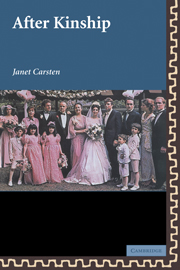Book contents
- Frontmatter
- Contents
- Acknowledgments
- 1 Introduction: After Kinship?
- 2 Houses of Memory and Kinship
- 3 Gender, Bodies, and Kinship
- 4 The Person
- 5 Uses and Abuses of Substance
- 6 Families into Nation : The Power of Metaphor and the Transformation of Kinship
- 7 Assisted Reproduction
- 8 Conclusion
- Bibliography
- Index
3 - Gender, Bodies, and Kinship
Published online by Cambridge University Press: 05 June 2012
- Frontmatter
- Contents
- Acknowledgments
- 1 Introduction: After Kinship?
- 2 Houses of Memory and Kinship
- 3 Gender, Bodies, and Kinship
- 4 The Person
- 5 Uses and Abuses of Substance
- 6 Families into Nation : The Power of Metaphor and the Transformation of Kinship
- 7 Assisted Reproduction
- 8 Conclusion
- Bibliography
- Index
Summary
The Hungarian Vlach Gypsies studied by Michael Stewart (1997) view men's and women's bodies as fundamentally different from each other. Their differences result from the polluting consequences of sexuality, which mean that women's bodies are potentially dangerous, and for this reason the separation between their lower and upper bodies must be symbolically marked. Women's lower bodies are covered by several layers of clothing, and cleanliness of the body is always rigidly marked off from processes of cooking and eating.
Among the Malay Muslims whom I studied on the island of Langkawi, women's behavior is often strikingly assertive, and women and men interact in many everyday contexts in a relaxed manner. And yet in more formal contexts, and at certain stages of their lives, quite strict rules of sex segregation apply. In a somewhat confusing way, these Malays seem to assert that men's and women's bodies are quite similar, but also appear in other ways to think of these bodies as quite different from each other.
In southern India, an old anthropological chestnut, Dravidian kinship, has recently been reanalyzed in terms of gendered similarity and gendered difference. Cecilia Busby (1997a, 2000) suggests that, rather than dividing the world simply into two, in terms of which relatives one may marry and which one may not, Dravidian kinship is fundamentally based on a radical distinction of relatedness that occurs between those of the same sex and between those of opposite sex.
- Type
- Chapter
- Information
- After Kinship , pp. 57 - 82Publisher: Cambridge University PressPrint publication year: 2003

